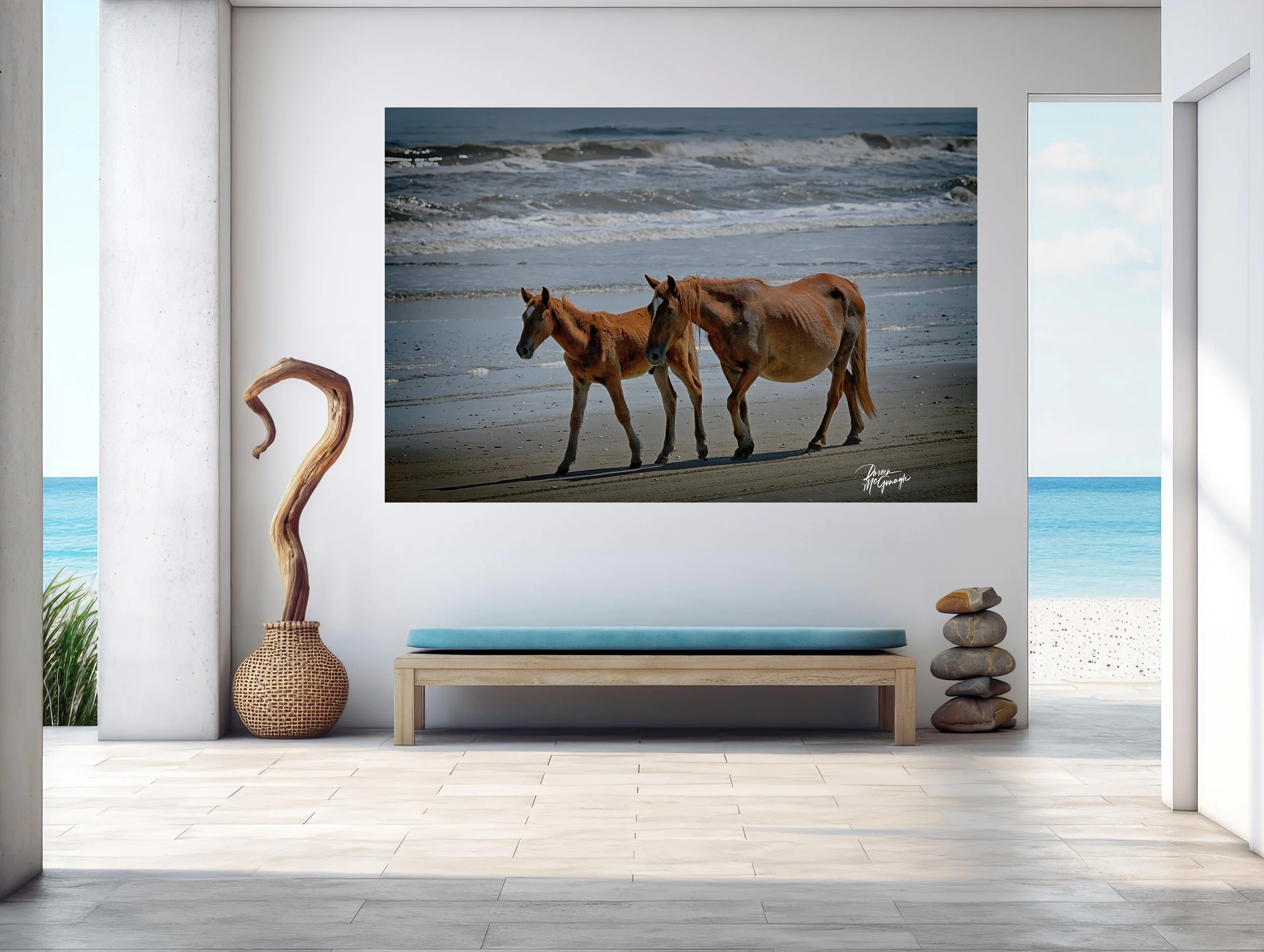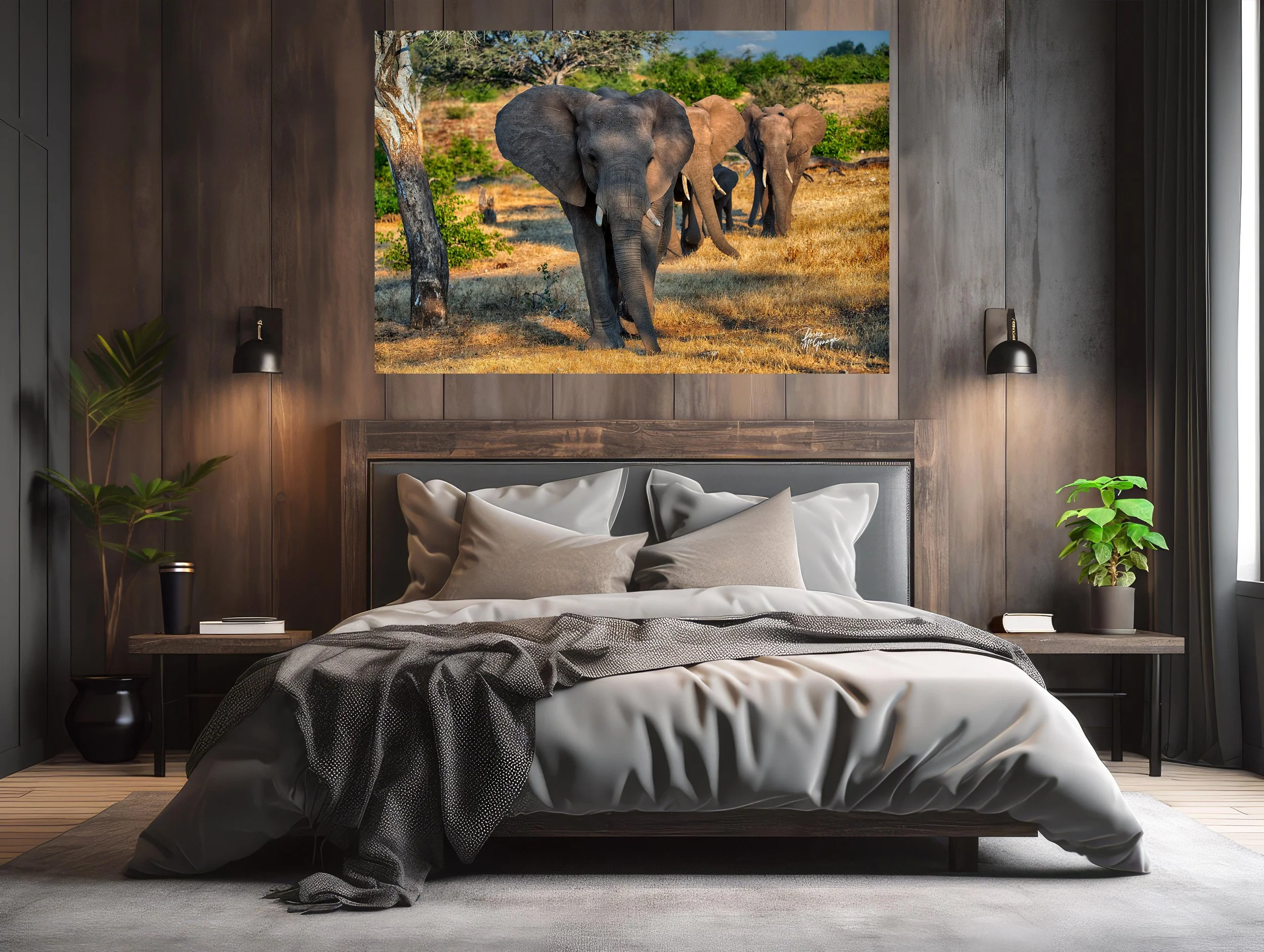Using Photography to Save Wildlife
In the intersection of art and activism, conservation photography emerges. It's a powerful tool that combines the beauty of wildlife photography with the urgency of nature preservation.
Equine Stroll by the Sea
OBX 5692-10 c2024 | North Carolina | Learn More
"Equine Stroll by the Sea" is a breathtaking piece of fine art photography that captures two magnificent horses gracefully walking along the tranquil sandy beach, with the serene ocean waves forming a peaceful backdrop. The soft hues of the horses, framed by the blue expanse of the sea, blend harmoniously with the sandy shore, evoking a sense of calm and natural beauty.
This form of environmental photography goes beyond capturing stunning images. It aims to inspire change and protect our planet's biodiversity. Conservation photography brings the unseen corners of our world into the public eye, sparking dialogue and action.
But how does one use a camera to save wildlife? What makes a photograph a catalyst for conservation?
In this article, we delve into the world of conservation photography. We explore its history, its impact, and the techniques used by photographers to tell compelling stories of our natural world.
Whether you're a seasoned photographer, a budding environmentalist, or simply a lover of nature, this guide will shed light on how photography can be a powerful ally in wildlife conservation.
Join us as we journey through the lens of conservation, and discover how you can play a part in preserving our planet's precious wildlife.
The Lens of Conservation: What Is Conservation Photography?
Conservation photography is a discipline that merges the art of capturing images with the science of biodiversity conservation. It's not just about taking visually appealing photos. It's about telling the stories of our planet's ecosystems, their inhabitants, and the threats they face.
This form of photography aims to raise awareness about environmental issues and inspire action. It's a powerful tool for education, advocacy, and change. Conservation photographers are not just artists, but also activists, educators, and storytellers, using their skills to make a difference in the world.
A Brief History: The Evolution of Conservation Photography
The roots of conservation photography can be traced back to the late 19th century. Pioneers like William Henry Jackson and Ansel Adams used their images to advocate for the creation of national parks in the United States. Their work highlighted the beauty of these landscapes and the need for their protection.
In recent years, the field has evolved to encompass a broader range of environmental issues. Modern conservation photographers document not only pristine wilderness but also the impacts of climate change, habitat destruction, and species extinction. Their work continues to play a crucial role in shaping public opinion and influencing policy.
The Power of an Image: How Conservation Photography Influences Change
Conservation photography goes beyond capturing stunning images of wildlife and landscapes. It's a powerful tool for change. The visual impact of a photograph can evoke strong emotions, making people more receptive to conservation messages.
Majestic Giants of Botswana
Botswana 2983-90 c2024 | Africa | Learn More
Experience the beauty and grace of Majestic Giants of Botswana, a breathtaking photograph capturing the essence of wildlife in their natural habitat. Witness the awe-inspiring sight of a group of elephants as they traverse the savannah, led by a magnificent leader with ears fanned out and eyes full of wisdom. The warm, golden light illuminates their rugged yet gentle features, bringing out every detail of their majestic presence.
Photographs can also provide undeniable evidence of environmental issues. Images of deforestation, pollution, and endangered species can raise public awareness and drive action. They can influence policy decisions and inspire individuals to support conservation efforts.
In essence, conservation photography is a form of visual storytelling. It's about conveying the beauty of nature, the threats it faces, and the need for its protection. It's a way to connect people with the natural world and inspire them to help preserve it.
Capturing the Wild: Techniques and Ethical Practices in Wildlife Photography
Wildlife photography is a blend of patience, skill, and respect for nature. It's about capturing the essence of an animal or habitat without causing harm or disturbance. This requires a deep understanding of wildlife behavior and a commitment to ethical practices.
Here are some key techniques and ethical considerations for wildlife photography:
Use a telephoto lens to keep a safe distance from animals.
Avoid using flash, as it can startle wildlife.
Learn about the species and its behavior to predict movements and capture natural shots.
Respect wildlife and their habitats. Don't disturb animals or damage their environment for the sake of a photo.
Follow local regulations and guidelines for wildlife photography.
Remember, the welfare of the subject and the environment should always come before getting the perfect shot. Conservation photography is about preserving nature, not exploiting it.
Stories That Speak: The Role of Narrative in Conservation Images
Conservation photography is more than just capturing stunning images of wildlife. It's about telling a story. A story that can inspire, educate, and provoke action.
Each image should convey a message about the importance of nature preservation. It should highlight the beauty of biodiversity, the threats it faces, and the urgent need for conservation. The power of visual storytelling can engage a wider audience and drive them to support conservation efforts. Remember, a picture is worth a thousand words, and in conservation photography, those words can make a world of difference.
From Passion to Action: Getting Involved in Conservation Photography
If you're passionate about wildlife and photography, why not combine the two? Conservation photography can be a rewarding way to contribute to nature preservation. You don't need to be a professional photographer to make a difference.
Start by learning about the local wildlife and their habitats. Understand the ethical considerations in wildlife photography. Collaborate with scientists, conservationists, and local communities. Use your images to raise awareness, support conservation initiatives, and inspire others. Remember, every image counts, and your contribution can make a real impact.
The Digital Age: Social Media and the Spread of Conservation Awareness
Social media has revolutionized the way we share and consume images. It has become a powerful tool for spreading awareness about wildlife conservation. Conservation images shared on platforms like Instagram, Facebook, and Twitter can reach a global audience in an instant.
""
However, it's important to share responsibly. Avoid revealing the exact locations of sensitive habitats or endangered species. Use your platform to educate your followers about conservation issues and inspire them to take action. Remember, with great reach comes great responsibility.
The Future Frame: Emerging Trends in Conservation Photography
As technology advances, so does the field of conservation photography. New tools like drones and camera traps are enabling photographers to capture images of wildlife and habitats from perspectives never before possible. These technologies are not only expanding the creative possibilities but also providing valuable data for conservation research.
At the same time, there's a growing emphasis on the importance of diversity and inclusion in conservation photography. This includes not only diversity in the species and ecosystems represented, but also in the voices and perspectives of the photographers themselves. The future of conservation photography is one of innovation, inclusivity, and impact.
Conclusion: Your Role in the Bigger Picture
In the grand scheme of nature preservation, every action counts. As a conservation photographer, your images can inspire change, educate others, and contribute to the protection of our planet's biodiversity. Remember, your lens is a powerful tool. Use it wisely to make a difference in the world of wildlife conservation.
Spirited Design Studio Fine Art Gallery proudly presents the curated fine art photography of Doreen McGunagle. Her work celebrates the breathtaking beauty of the natural world, inviting you to pause, reflect, and forge a deep connection with the environment. Through her extraordinary images, Doreen McGunagle offers a window into the stunning landscapes and wildlife that fuel her creative inspiration.
Whether you’re a seasoned art collector or exploring fine art photography for the first time, we invite you to explore our collection and discover the beauty that awaits. Every image tells a unique story, and Doreen is committed to capturing the awe-inspiring moments that make nature so remarkable. Embark on this journey with us and let the splendor of nature inspire and uplift your spirit.
Explore our online gallery of limited-edition conservation fine art prints. Join us in celebrating and preserving the beauty of our natural world through our exquisite collection of fine art photography.


